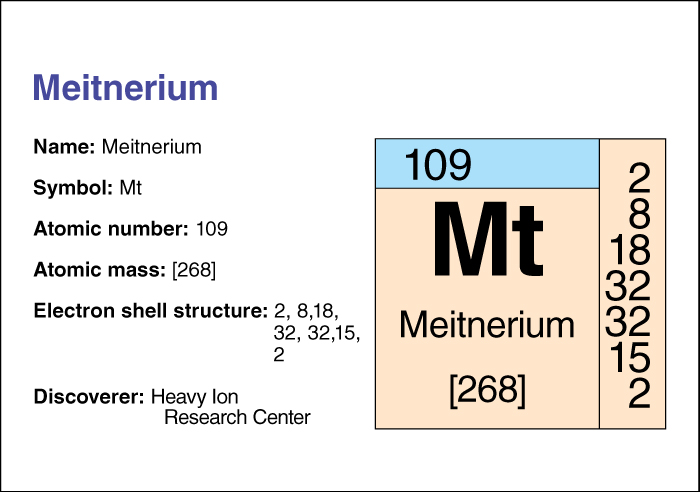Meitnerium is an artificially produced radioactive element with 109 protons–that is, with an atomic number of 109. Scientists have discovered more than one isotope of meitnerium. Isotopes of an element have the same number of protons but different numbers of neutrons. The most stable isotope of meitnerium has an atomic mass number (total number of protons and neutrons) of 268. This isotope has a half-life of 0.070 second—that is, due to radioactive decay, only half the atoms in a sample of isotope 268 would still be atoms of that isotope after 0.070 second.

The chemical symbol for meitnerium is Mt. Chemists place meitnerium in the tansactinide group of transuranium elements . For information on the position of meitnerium on the periodic table, see the article Periodic table .
In 1982 and 1984, scientists at the Heavy Ion Research Center in Darmstadt, West Germany (now part of Germany), made claims for the production of the element. They bombarded bismuth, which has an atomic number of 83, with iron, which has an atomic number of 26. In 1985, scientists at the Joint Institute for Nuclear Research in Dubna, near Moscow, produced results that agreed with the Darmstadt claim. Dubna was then part of the Soviet Union and is now in Russia. Further work at Darmstadt in 1988 also agreed with the earlier claims.
In 1986, the International Union of Pure and Applied Chemistry (IUPAC) and the International Union of Pure and Applied Physics formed a working group to review the histories of the elements with atomic numbers from 101 to 109. In 1993, IUPAC accepted the working group’s conclusion that the West Germans had first produced the element in 1982. But disagreements about what to name the element delayed an official naming until 1997.
Meitnerium is named after Austrian-born physicist Lise Meitner , who played an essential role in the discovery of nuclear fission, the splitting of the atomic nucleus.
